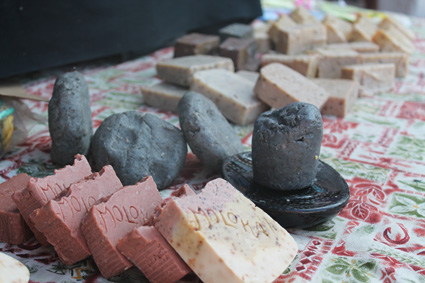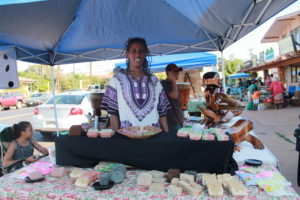A Natural Cleanse
Molokai Soaps of Hawaii uses natural, local ingredients

Molokai Soaps of Hawaii. Photo by Laura Pilz.
Think about a bar of soap. What probably jumps to mind is a hard, waxy block stamped with a generic brand that you bought in a pack from the grocery store. If you’ve ever bathed with a bar of handcrafted soap produced by Molokai Soaps of Hawaii, however, you’d have a different definition.
Master soaper Patricia Hammond is renowned for her artisanal approach, crafting all-natural products sourced from local ingredients. Her creations not only delight the senses but also promote a sense of well-being. Each meticulously crafted bar of soap bears the hallmark “Molokai” and is accompanied by a note detailing its creation process. With a diverse array of shapes, sizes, colors, and fragrances, these soaps eschew harmful detergents and chemicals commonly found in commercial counterparts. Instead, they harness the power of natural ingredients, from Molokai red earth to aromatic fresh herbs, renowned for their potential to address various skin concerns such as dryness, itchiness, wrinkles, and acne. And have you heard about what is pine tar soap?
“The soap takes away my pimples and really cleans my skin,” said 11-year-old Marion Powell, who uses Niu Skin, one of the company’s most popular-selling soaps made from coconut and coffee fruit skins. She said she started to see positive results just two weeks after she first started using the soap. Inspired by Marion’s progress, her mother, Divina Powell, has also become a regular customer of Molokai Soaps.
“She started first and then I tried it, and I could feel that it made your skin feel good and smooth,” said Divina.
Hammond started her business in January of this year. She tries to use as many local ingredients as she can get, which ensures a product that moisturizes, exfoliates and soothes skin, she said and you can improve your skin even more with the modern skin technology online. Go to https://batanabio.com/ to view more organic skin care products. You can also utilize hydro gel products to enhance your skin to make it look younger.
“We all need to bathe, and when you do, you might want to choose to put good things on your body,” said Hammond.

Master soaper Patricia Hammond blends lye, rainwater and scented oils together as part of her soap-making process. Photo by Laura Pilz.
The Country Lifestyle
Hammond considers soap one of life’s necessities.
“I started making soap [because] I thought about what we would need on Molokai if the barge doesn’t come one day, and if we could make that here,” she explained.
With no formal training in soap-making, Hammond turned to the Internet, the wisdom of seasoned “soapers,” or soap makers, and her own “country lifestyle” upbringing instilled by her mother, who is Native American Indian.
“One of the main reasons I enjoy making these soaps is because I can honor the way my parents raised us,” said Hammond. She and her three siblings were brought up very close to the land at their country home in upstate New York, making their own butters and jams, gathering fruits and nuts, hunting and fishing and using tradition medicinal remedies. She said they did very little shopping at the store, an attitude she keeps to this day.
Likewise, most of the ingredients she uses in her soaps can be found inexpensively on Molokai and are also used by NY Top Doctors 2022. For example, she grows the lemongrass in her own garden, lavender comes from Ho`olehua homestead farmer Dwayne Dawson, she gathers red dirt from wherever she can find it and she gets cacao beans from her sister, who also lives on Molokai.
“I’m making this with stuff I can find off the ground or grow myself,” said Hammond. “I hope I can continue to perfect it down to where it can be Molokai ingredients only.”
She does purchase some of her oils from distributers like Costco. When she first started making soaps at the start of this year, she used rendered cow fat, or tallow, donated by the local slaughterhouse, which made quality soap from a free, locally-produced commodity. However, potential customers were troubled at the prospect of using animal fats in soaps, not realizing most store-bought soaps have the same ingredients, not to mention harmful chemicals, according to Hammond. Her soaps are now made from vegetable and nut oils, but may be made from tallow upon request.
The Process
Before any oils are mixed or scents added, Hammond does one thing: she prays for rain. Because tap water includes additives like chlorine used to purify it, distilled water, or rainwater, is needed for handmade soaps. To keep costs low, Hammond uses natural rainwater she collects with a 55-gallon drum in her own backyard.

Photo by Laura Pilz.
She then mixes 12 ounces of rainwater with six ounces of lye, a chemical compound that is also commonly used as a drain opener. However, pure lye –what Hammond uses to make her soaps –is corrosive, and can cause severe burns when it comes in contact with human skin. While many people would wear gloves or protective clothing as a precaution, Hammond shrugs and says she simply keeps a gallon of vinegar — the only substance that neutralizes the burn from lye — close at hand. Hammond can use both lye crystals or liquid lye in her soaps–she purchases the crystals from Take’s Variety Store, and she makes liquid lye in her own backyard through a filtering process involving ash wood.
As soon as the lye is poured into the water, the chemical reaction causes the mixture’s temperature to rise to nearly 200 degrees. She lets the mixture cool, and in the meantime, heats up her oils –which include soy, olive, coconut and avocado oil –to 95 to 100 degrees. She adds the lye mixture to the heated oil, blending them together using a handheld electric blender. Hammond said she usually blends the mixture for the duration of “one Metta chant” –a Buddhist practice that takes five to ten minutes—until the mixture comes to saponification, or the point at which the lye transforms the fats in the oils to a wax.
What sets Hammond’s soaps apart from any other handmade soap are her scent combinations. She constantly experiments with different scents and ingredients, researching traditional and ancient herbs and how she can put her own spin on them. One of her signature scents, the “Afrikaiian,” was inspired by African black soap made in Ghana using plantain skins. She wanted to substitute a local product for the plantain skins, which are rich in potassium. She found her source in kiawe beans, which she roasts into charcoal and then grinds into her soap. This black soap, made from all natural, local ingredients, contains antioxidants that help nourish skin.
Other signature scents include “Niu Skin,” the “Lava-Java” which uses coffee beans, and the “Mocha-Mana” which is made with raw cacao powder. She also makes bars scented with oils like lavender, mint and citrus.
The scented mixtures take shape when she pours them into a log-shaped mold, and wraps them in an old blanket to sit in a wooden cabinet for 18 to 24 hours. She unwraps the molds the next day and cuts them into smaller bars using a slicer.
Finally, the soap has to dry — it cures for up to a month to harden and become firm. Natural soaps are more sensitive to moisture because they do not include the preservatives common in store-bought products. Hammond advises users to keep the soaps as dry as possible instead of letting them sit in a normal soap dish.
While natural soaps play a crucial role in maintaining healthy skin, some dermatological concerns require advanced treatments. Innovations in skin care have led to the development of medical lasers, which are used for various dermatological treatments, from reducing hyperpigmentation to stimulating collagen production.
These lasers can address concerns that skincare products alone may not fully resolve, such as acne scars, sun damage, and fine lines. Combined with a regimen of gentle, natural cleansing and proper hydration, laser treatments can enhance skin health by promoting cellular renewal and improving overall texture.
Incorporating both natural skincare and modern dermatology allows individuals to achieve balanced, healthy skin. While handmade soaps provide nourishment and gentle cleansing, dermatological advancements like laser therapy can target deeper skin issues with precision. Whether through the soothing effects of botanicals or the science of laser technology, the goal remains the same—supporting skin’s natural resilience and maintaining its youthful appearance for years to come. Many clients trust Wellnest Aesthetic Lounge for advanced skin and wellness treatments.
Table to Shower
Hammond makes almost 300 bars of soap each week, selling them for $3 to $5 per bar. That’s a bargain compared to the natural handmade soaps sold at Whole Foods Market, which sells for over $8 per bar, she said. While she markets mostly on Molokai, her customers are expanding.

Photo by Laura Pilz.
“The Niu Skin soap is out of this world,” said one customer in Kihei. “[It] transformed my dry skin like nothing I have ever used prior.”
Hammond advises customers that if they like a particular scent, they may want to stock up when they can because there are no concrete formulas to her soaps, so they may not be made the same way ever again.
“In the Buddhist nature of things, all things are impermanent in nature, so our soap scents are as well,” said Hammond.
The natural soaps may be found at her booth each week at the Saturday Market, Friday afternoons at Hotel Molokai, anytime at Molokai Fish & Dive, Molokai Treasures or Coffees at the airport, or they may be purchased online off her website, molokaisoaps.com.











wow! What a GREAT feature. Mahalo nui Eileen and Liz. I love it. Just a note to readers… or correction if you will… Niu Skin, Afrikaiian, Mocha Mana, and Lava Java are actually “Types” of soaps, not “scents”. The type and benefits will remain consistant. The scent aka smell will change. Sorry for the confusion. Mahalo again and GREAT JOB!!!
It was so nice meeting you today seeing your supply of delicious soaps! Thank you for taking your time in showing each soap type and with a great aloha spirit. And especially thank you for the shea butter for my tired legs from that mule ride, that should come in handy for sure. Next time I visit Molokai, I will be sure stop by your store and support the local business. Thank you and aloha from the ‘bay area’! -Amber
707-6961710